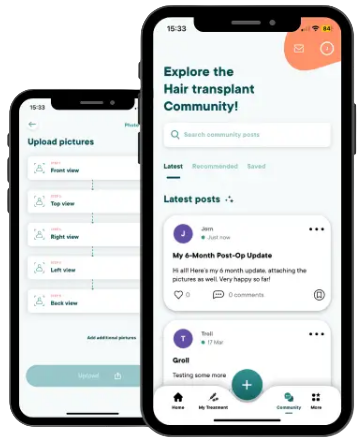In this guide
Robotic hair transplant is one of the most advanced solutions in the field of hair restoration. With its cutting-edge technology, this procedure has become a popular choice for people experiencing hair loss.
Unlike traditional methods, which rely on manual techniques, robotic hair transplants use artificial intelligence (AI) and robotics to provide greater precision, efficiency, and natural-looking results.
However, as with any medical procedure, it’s essential to have clear expectations about what the process involves, the results it can provide, and the factors that might influence those results.
My name is Emma Wright, your resident hair restoration specialist. Today, we’ll take a deep dive into Understanding Robotic Hair Transplant Technology.
This guide will take you through the entire journey of a robotic hair transplant, from understanding the technology behind it to managing your expectations post-procedure.
Whether you’re considering the procedure for yourself or simply curious about the process, this guide will provide you with the necessary information to make an informed decision about robotic hair transplants.
Understanding Robotic Hair Transplant Technology
What is Robotic Hair Transplant?
A robotic hair transplant is a modern technique that leverages robotics and artificial intelligence (AI) to assist in the extraction and transplantation of hair follicles. It utilizes advanced systems like the ARTAS system, which automates the follicle extraction and implantation processes, ensuring a high level of precision.
The main difference between traditional hair transplants and robotic ones is the use of technology to improve the accuracy of the process and minimize human error.
The robotic hair transplant system works by using 3D imaging to map out the donor area of the scalp, which is typically located at the back or sides of the head. From here, the robot carefully extracts individual hair follicles while preserving the surrounding tissue.
This approach results in less trauma to the scalp, fewer risks, and a higher success rate of the transplanted follicles. The use of robotics allows for faster, more consistent, and more natural-looking results when compared to traditional methods.
Additionally, the AI-powered system ensures that follicles are extracted at the optimal depth and angle, mimicking the natural growth pattern of the hair. This high level of precision is one of the reasons why robotic hair transplants are often preferred by patients seeking a more natural outcome.
The Robotic Hair Transplant Procedure
The robotic hair transplant procedure is a straightforward process, though it does require careful planning and attention to detail. Here’s a breakdown of what you can expect during the procedure:
- Consultation and Assessment: The first step involves a consultation with a hair transplant specialist, where your scalp condition, medical history, and expectations will be discussed. The doctor will assess your hair loss pattern, the health of your donor area, and determine if you are a good candidate for the procedure.
- Marking the Scalp: After approval, the doctor will mark the areas of the scalp that will be treated. This includes the donor area, where the hair follicles will be extracted, and the recipient area, where the hair will be transplanted.
- Follicle Extraction: The robotic system uses AI and 3D imaging to identify the best hair follicles for extraction. The robot performs this process with extreme precision, minimizing damage to the donor area and ensuring that follicles are extracted at the correct angle and depth for optimal growth.
- Graft Preparation: Once the follicles are extracted, they are carefully prepared for transplantation. The robotic system sorts the follicles based on their size and quality to ensure the healthiest follicles are used.
- Implantation: The robot then uses the same precision to implant the follicles into the recipient area. The system ensures that the hair follicles are placed at the correct angle to mimic the natural direction of your existing hair, providing a more seamless, natural look.
Overall, the robotic hair transplant procedure typically takes several hours, depending on the extent of the transplant. Most patients can go home the same day, though some might experience mild discomfort or swelling.
Benefits of Robotic Hair Transplant
The robotic hair transplant procedure offers several advantages over traditional methods. Here are some key benefits that set robotic hair restoration apart:
- Precision and Accuracy: The primary benefit of a robotic hair transplant is its precision. By using AI and robotics, the system ensures that hair follicles are extracted and implanted with extreme accuracy, mimicking natural hair growth patterns. This leads to more consistent, natural-looking results.
- Minimized Follicle Damage: Traditional hair transplants often involve manual follicle extraction, which can result in damaged or improperly harvested follicles. The robotic system minimizes this risk by extracting follicles with minimal trauma, improving the overall success rate of the transplant.
- Faster Recovery Time: Since the procedure is minimally invasive, patients typically experience faster recovery times compared to traditional hair transplants. The robotic system uses smaller incisions and requires less downtime, so patients can return to normal activities more quickly.
- Reduced Risk of Complications: With human error minimized, the risk of complications such as scarring, infection, or unnatural hair placement is significantly reduced. The robot follows pre-programmed parameters, ensuring the procedure is consistent every time.
- Enhanced Aesthetic Outcomes: The robotic system ensures that hair follicles are placed at the optimal angle and direction, which helps to achieve more natural, aesthetically pleasing results. The precision allows for a fuller and more balanced hairline.
Ideal Candidates for Robotic Hair Transplants
Not everyone is a good candidate for a robotic hair transplant. The best candidates for the procedure typically have the following characteristics:
- Healthy Scalp and Hair: Ideal candidates have healthy hair follicles in the donor area, typically the back or sides of the head. The quality and quantity of these follicles play a crucial role in the success of the procedure.
- Stable Hair Loss: If your hair loss is ongoing or progressive, you may not be an ideal candidate. It’s best to undergo the procedure when hair loss has stabilized to prevent further thinning after the transplant.
- Realistic Expectations: Candidates should have realistic expectations about what the procedure can achieve. While robotic hair transplants can significantly improve the appearance of thinning or receding hairlines, they may not be able to restore full hair density in cases of advanced hair loss.
- General Good Health: Patients need to be in good overall health, as the procedure requires some healing afterward. Individuals with chronic conditions such as diabetes or autoimmune disorders may not be ideal candidates unless their condition is well-managed.
Managing Expectations and Realistic Outcomes
Expected Results from Robotic Hair Transplants

After a robotic hair transplant, patients can expect to see gradual improvement in the density of their hair. The results typically take several months to become noticeable, with the full effects visible within 9 to 12 months. The transplanted hair will fall out initially, but new hair will begin to grow in its place.
It’s important to understand that the robotic hair transplant procedure cannot stop the natural progression of hair loss in non-transplanted areas. While the transplanted hair will be permanent, patients may experience further thinning in untreated areas over time.
Post-Procedure Expectations
Recovery after a robotic hair transplant is typically quick, but it’s important to manage expectations for the immediate post-operative period. In the first few days, you may experience some swelling, redness, or mild discomfort. These symptoms are normal and usually subside within a week.
The transplanted hair may shed within the first few weeks as the follicles enter a resting phase, but this is temporary. New hair growth will begin after 3 to 6 months, with full results visible after about a year. It’s essential to follow all aftercare instructions to minimize complications and promote healthy regrowth.
Limitations of Robotic Hair Transplants
While robotic hair transplants offer many benefits, they are not without limitations. These include:
- Limited Donor Hair: If you have a limited amount of healthy donor hair, the results may be less dramatic. In such cases, alternative methods or multiple sessions may be necessary.
- Not for Extensive Hair Loss: The procedure is generally more effective for patients with early to moderate hair loss. Individuals with extensive hair loss may not achieve the full restoration they desire, as robotic hair transplants may not be able to cover large areas.
- Maintenance: While the transplanted hair will grow permanently, patients may need to maintain their results with other treatments, such as medications, to prevent further hair thinning.
Realistic Expectations for Different Hair Types and Loss Stages
The success of a robotic hair transplant can vary depending on your hair type and stage of hair loss. Those with finer hair or early-stage hair loss tend to see the best results, as the procedure can restore a natural hairline and improve overall density.
For individuals with more advanced hair loss or coarser hair, the procedure may improve the aesthetic appearance but may not fully restore the hair’s original density.
Why Setting Expectations is Key to Satisfaction
Setting realistic expectations is essential to ensure satisfaction with your robotic hair transplant. While the procedure offers significant improvements, it’s important to understand that it’s not a cure-all for hair loss. Having a clear discussion with your surgeon about your goals and potential outcomes will help you avoid disappointment and achieve the best possible result.

Emma, staff writer and
Hair Restoration Specialist.
Hi, I’m Emma! While some people can recover from stress-related hair loss naturally, there are alternative solutions if that doesn’t work for you. A hair transplant is a permanent option that can restore your confidence and give you real results.
I know how crucial it is to get the right guidance. That’s why I’m recommending a free consultation with a specialist, where you can ask all your questions and explore your options.
Conclusion
In conclusion, a robotic hair transplant can be a life-changing procedure for individuals experiencing hair loss. With its advanced technology, precision, and minimal recovery time, it offers a reliable solution for many seeking to restore their hairline.
However, it’s crucial to set realistic expectations and understand the limitations of the procedure. Consulting with a skilled surgeon and following proper aftercare will ensure the best possible outcome, giving you the confidence to enjoy your natural-looking results.


